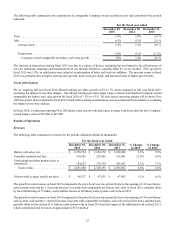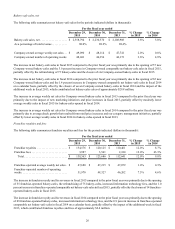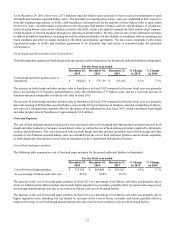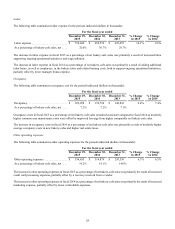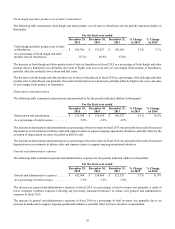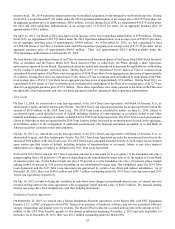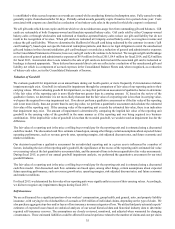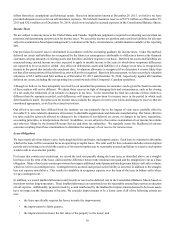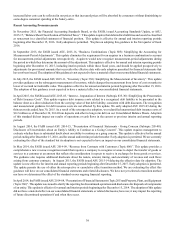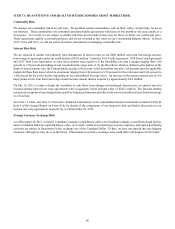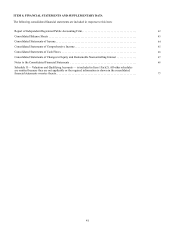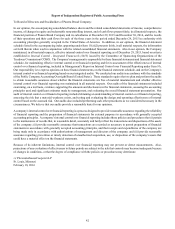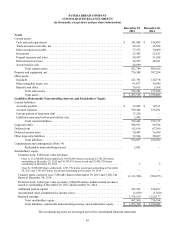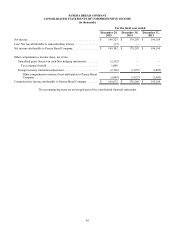Panera Bread 2015 Annual Report Download - page 45
Download and view the complete annual report
Please find page 45 of the 2015 Panera Bread annual report below. You can navigate through the pages in the report by either clicking on the pages listed below, or by using the keyword search tool below to find specific information within the annual report.35
is established within accrued expenses as rewards are earned while considering historical redemption rates. Fully earned rewards
generally expire if unredeemed after 60 days. Partially earned awards generally expire if inactive for a period of one year. Costs
associated with coupons are classified as a reduction of net bakery-cafe sales in the period in which the coupon is redeemed.
We sell gift cards which do not expire and from which we do not deduct non-usage fees from outstanding gift card balances. Gift
cards are redeemable at both Company-owned and franchise-operated bakery-cafes. Gift cards sold by either Company-owned
bakery-cafes or through wholesalers and redeemed at franchise-operated bakery-cafes reduce our gift card liability but do not
result in the recognition of revenue. When gift cards are redeemed at Company-owned bakery-cafes, we recognize revenue and
reduce the gift card liability. When we determine the likelihood of the gift card being redeemed by the customer is remote ("gift
card breakage"), based upon our specific historical redemption patterns, and there is no legal obligation to remit the unredeemed
gift card balance in the relevant jurisdiction, gift card breakage is recorded as a reduction of general and administrative expenses
in the Consolidated Statements of Income; however, such gift cards will continue to be honored. We recognized gift card breakage
as a reduction of general and administrative expenses of $6.9 million for fiscal 2015, $4.9 million for fiscal 2014, and $2.8 million
for fiscal 2013. Incremental direct costs related to the sale of gift cards are deferred until the associated gift card is redeemed or
breakage is deemed appropriate. These deferred incremental direct costs are reflected as a reduction of the unredeemed gift card
liability, net which is a component of accrued expenses in the Consolidated Balance Sheets and, when recognized, as a reduction
of bakery-cafe sales, net in the Consolidated Statements of Income.
Valuation of Goodwill
We evaluate goodwill for impairment on an annual basis during our fourth quarter, or more frequently if circumstances indicate
impairment might exist. Goodwill is evaluated for impairment through the comparison of fair value of our reporting units to their
carrying values. When evaluating goodwill for impairment, we may first perform an assessment of qualitative factors to determine
if the fair value of the reporting unit is more-likely-than-not greater than its carrying amount. If, based on the review of the
qualitative factors, we determine it is not more-likely-than-not that the fair value of a reporting unit is less than its carrying value,
we bypass the required two-step impairment test. If we do not perform a qualitative assessment or if the fair value of the reporting
unit is not more-likely- than-not greater than its carrying value, we perform a quantitative assessment and calculate the estimated
fair value of the reporting unit. If the carrying value of the reporting unit exceeds the estimated fair value, there is an indication
that impairment may exist. The amount of impairment is determined by comparing the implied fair value of the reporting unit
goodwill to the carrying value of the goodwill in the same manner as if the reporting unit was being acquired in a business
combination. If the implied fair value of goodwill is less than the recorded goodwill, we would record an impairment loss for the
difference.
The fair value of a reporting unit is the price a willing buyer would pay for the reporting unit and is estimated using a discounted
cash flow model. The discounted cash flow estimate is based upon, among other things, certain assumptions about expected future
operating performance, such as revenue growth rates, operating margins, risk-adjusted discount rates, and future economic and
market conditions.
Our decision to perform a qualitative assessment for an individual reporting unit in a given year is influenced by a number of
factors, including the size of the reporting unit's goodwill, the significance of the excess of the reporting unit's estimated fair value
over carrying value at the last quantitative assessment date, and the amount of time in between quantitative fair value assessments.
During fiscal 2015, as part of our annual goodwill impairment analysis, we performed the quantitative assessment for our total
goodwill balance.
The fair value of a reporting unit is the price a willing buyer would pay for the reporting unit and is estimated using a discounted
cash flow model. Our discounted cash flow estimates are based upon, among other things, certain assumptions about expected
future operating performance, such as revenue growth rates, operating margins, risk-adjusted discount rates, and future economic
and market conditions.
For fiscal 2015, we determined the fair value of our reporting units were significantly in excess of their carrying values. Accordingly,
we did not recognize any impairment charges during fiscal 2015.
Self-Insurance
We are self-insured for a significant portion of our workers’ compensation, group health, and general, auto, and property liability
insurance, with varying levels of deductibles of as much as $0.8 million of individual claims, depending on the type of claim. We
also purchase aggregate stop-loss and/or layers of loss insurance in many categories of loss. We utilize third party actuarial experts’
estimates of expected losses based on statistical analyses of our actual historical data and historical industry data to determine
required self-insurance reserves. The assumptions are closely reviewed, monitored, and adjusted when warranted by changing
circumstances. These estimated liabilities could be affected if actual experience related to the number of claims and cost per claim


